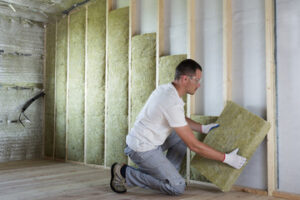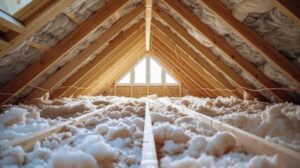Pest Control involves managing harmful insects, rodents and other organisms that damage crops or spoil possessions. Methods of control include prevention, suppression and eradication.
Pheromones can help monitor and control pest populations. Adding or subtracting certain hormones can alter the reproductive cycle, keeping pest numbers below economic damage levels. Contact Nature Shield Pest Solutions now!

A successful pest control strategy focuses on reducing the number of pests to an acceptable level that causes as little harm as possible. This can be accomplished by prevention, suppression or eradication of the pests. Prevention means not allowing pests to reach unacceptable numbers; suppression is reducing the numbers of the pests to a point where their damage is acceptable; and eradication is eliminating an entire pest population.
Environmental factors limit the growth of many pest populations, such as weather or topography. Other limitations can include the availability of food or water, the ability of the host plant to resist attack by the pest, and the presence of predators or parasites that injure or kill the pest.
In crop fields, different natural enemy guilds — such as parasitoids and ground-dwelling predators — may interact with each other to influence the strength of their pest-control services. The interaction effects can be null, additive, or antagonistic based on their relative importance to the overall ecosystem service of controlling pests. Increasing the diversity of natural enemies, such as through conservation strategies and the release of beneficial insects and nematodes, can improve biological pest control in crop fields.
Some varieties of plants, trees, or animal species are more resistant to pests than others, so using them can reduce pest problems. Planting resistant species or making use of natural barriers (such as mountains and rivers) can also help prevent the spread of pests. Chemicals can be used to repel or poison pests, and pheromones can confuse male pests and discourage them from mating. Physical barriers, such as netting, grid wires or spikes can prevent pest access to desirable plants; and mulch can inhibit weed germination or deter pests from damaging soil.
Prevention
Pest prevention involves foreseeing possible pest problems and taking action to mitigate them before they occur. It is more effective than the reactive approach of treating an infestation since it reduces the need for costly and disruptive pest control measures. It also helps protect human health by minimizing the transmission of diseases and supporting a cleaner, safer living environment.
Structural preventive measures include identifying and eliminating entry points into an establishment, decluttering storage areas and removing food sources, and using a regular cleaning schedule to ensure that pests don’t find their way inside. This includes a consistent garbage disposal routine, keeping all food in sealed containers, and repairing leaky pipes to stop water from attracting pests. It also means establishing clear protocols for employees, from the c-suite to the loading dock, on how to inspect incoming shipments for signs of pests and taking immediate corrective action.
Preventative pest control also focuses on the landscape of an establishment and making sure that there are no natural habitats for pests to live in. This could involve removing trees that are likely to attract pests and pruning or mulching around the foundation of buildings. It might also mean implementing landscaping techniques that encourage wildlife such as birds, reptiles, and fish that can help control pest populations.
The judicious use of chemicals can play a role in preventative pest management, but only when applied by a certified professional. The proper choice of products for the specific pests and their application methods will reduce potential health risks, environmental impact, and public exposure to toxic chemicals. In addition, preventing the spread of pests by improving sanitation and reducing the availability of food or shelter will limit their population growth.
Eradication
In pest control, the term threshold refers to a level at which the pest population is either too low or too high to be controlled without intervention. Thresholds are established for continuous pests, which occur continually and require regular control; sporadic pests, which are migratory, cyclical or other occasional; and potential pests, organisms that are not pests under normal conditions but may become a nuisance and require treatment under some circumstances.
Threshold levels are established by approximating the number of pests that can cause unacceptable damage to plant health or visual appeal. To make these estimates, homeowners must know the pest’s life cycle, population history and damage levels. They also must decide whether the pest’s numbers will increase until they are controlled by natural enemies or weather conditions limit population growth.
Pesticides are the fastest way to reduce pest populations. Unfortunately, they also have serious drawbacks, including direct hazards to the user and unintended environmental consequences. In addition, some pesticides kill beneficial insects and their eggs or leave behind a residue that is harmful to other plants or animals.
When selecting a chemical pesticide, it’s important to read the label carefully and follow all directions for application. Sometimes, even when all precautions are taken, pesticide applications fail to control the targeted pests. If this happens, a careful evaluation of the pest infestation and consideration of other controls must be made. For example, if the pest is a larva that can be controlled with a commercial predator, it’s important to apply the predator when the pest is young, before it matures and becomes difficult or impossible to kill. This is usually in the spring. Similarly, if the pest can be controlled with a biological management method, it’s important to apply the control when the pest is in an appropriate stage of development for that technique.
Mechanical or Physical Controls
The use of equipment or supplies to cut, crush, bury or exclude pests with barriers such as fences, nets, radiation, and heat or to alter the environment by cooling, heating, evaporating, or restricting light is known as mechanical or physical control. Such methods can also include crop rotation, planting thick or shallow weed mats, flaming, and burning plants, burying or killing them by plowing, cultivation, tillage, mowing or harvesting. The use of machinery to destroy, reclaim or clean up aquatic plants and organic materials from waterbodies is also a form of mechanical control.
Biological controls use natural predators, parasites, fungi and other organisms to kill or reduce the population of unwanted insects, weeds, pathogens, and diseases. These methods are becoming more popular among organic growers and some consumers. These methods are more humane than chemicals but can be difficult to establish and maintain. Often, they must be reinforced with other techniques, such as increasing the number of natural enemies or adjusting weather conditions to suppress pests.
Traps are an effective mechanical control, reducing pest populations by attracting and capturing the pests. A variety of traps are available, including sticky traps, colored traps, pheromone traps and light traps. A knowledge of the habits and biology of the target pest is helpful to select and position traps correctly.
A number of factors affect pest population levels, including climate and natural enemies. It is important to monitor pests and their damage, using action thresholds as guidelines for when to control them. These thresholds are usually defined for each pest and vary by crop. Contact your state IPM program personnel for local information on action thresholds. To be successful, all IPM strategies must be implemented and managed carefully. Always follow product label instructions, and always wear personal protective equipment (PPE) when applying pest controls.
Biological Controls
Biological pest control relies on predators, parasites and pathogens (known as natural enemies) to reduce or eliminate pest populations without using chemical pesticides. This is a sustainable, long-term solution for farm, garden and greenhouse production.
These natural enemies may be naturally resident in the environment, already controlling a pest population, or they can be introduced and augmented into the growing area, with the goal of permanently eliminating the pest. This is called classical biological control.
In other cases, the augmentation is done to reduce a pest outbreak. For example, when the European corn borer was causing problems in the Midwest, farmers used a parasitic wasp, Trichogramma ostriniae, to control it.
Predator exclusion cages are sometimes used to measure attack rates of parasitoids or predators on sentine prey, such as aphids, spider mites and caterpillars, to determine their potential for biological control. Other augmentation methods include introducing predators that are capable of attacking different stages of the pest life cycle, or releasing predators in large numbers to overwhelm or deplete the pest population.
Many augmentation techniques involve the use of semiochemicals, such as plant-released alarm pheromones, to induce pest avoidance behaviors. These non-consumptive effects are generally less well studied than the consumption of the pest by the predator or parasitoid.
For both kinds of biocontrol, it is important to understand that a crop’s intrinsic defenses must also be utilized. This is often referred to as preventative biocontrol. The crop must be scouted and protected to minimize damage from the pest, and a management plan must be put in place. This requires more record-keeping and patience than suppression and eradication, but it can offer the best long-term solution for pests that cannot be eliminated with non-chemical controls.








